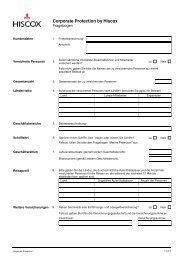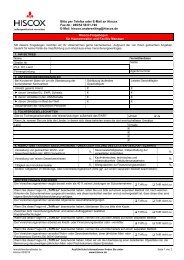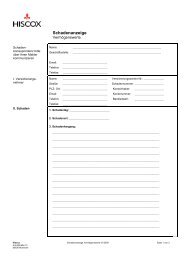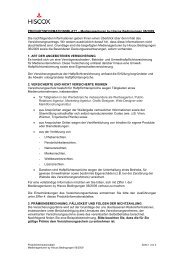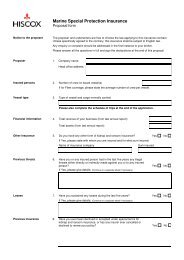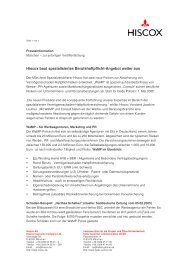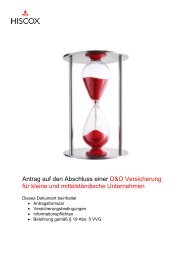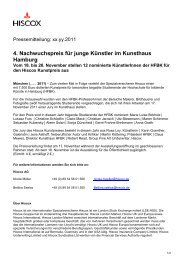Download PDF - Hiscox
Download PDF - Hiscox
Download PDF - Hiscox
You also want an ePaper? Increase the reach of your titles
YUMPU automatically turns print PDFs into web optimized ePapers that Google loves.
3 Management of risk continued<br />
3.2 Financial risk continued<br />
(b) Interest rate risk continued<br />
The fair value of debt and fixed income<br />
assets in the Group’s balance sheet at<br />
31 December 2009 was £2,256 million<br />
(2008: £1,929 million). These may be<br />
analysed as follows:<br />
Nature of debt and<br />
fixed income holdings<br />
2009 2008<br />
% weighting % weighting<br />
Government issued bonds<br />
and instruments 28 35<br />
Agency and Government<br />
supported debt 28 17<br />
Asset backed securities 6 10<br />
Mortgage backed<br />
instruments – Agency 4 8<br />
Mortgage backed<br />
instruments – Non-agency 6 8<br />
Corporate bonds 26 20<br />
Lloyd’s and money<br />
market deposits 2 2<br />
One method of assessing interest rate<br />
sensitivity is through the examination of<br />
duration-convexity factors in the underlying<br />
portfolio. Using a duration-convexity based<br />
sensitivity analysis, if market interest rates<br />
had risen by 100 basis points at the balance<br />
sheet date, the fair value might have been<br />
expected to decrease by £32 million<br />
(2008: decrease of £31 million) assuming<br />
that the only balance sheet area impacted<br />
was debt and fixed income financial assets.<br />
Duration is the weighted average length<br />
of time required for an instrument’s<br />
cash flow stream to be recovered, where<br />
the weightings involved are based on the<br />
discounted present values of each cash<br />
flow. A closely related concept, modified<br />
duration, measures the sensitivity of the<br />
instrument’s price to a change in its yield<br />
to maturity. Convexity measures the<br />
sensitivity of modified duration to changes<br />
in the yield to maturity.<br />
Using these three concepts, scenario<br />
modelling derives the above estimated<br />
impact on instruments’ fair values for a 100<br />
basis point change in the term structure of<br />
market interest rates.<br />
Insurance contract liabilities are not directly<br />
sensitive to the level of market interest rates,<br />
as they are undiscounted and contractually<br />
non-interest-bearing. The Group’s debt and<br />
fixed income assets are further detailed at<br />
note 20.<br />
At 31 December 2009, £138 million was<br />
drawn on the Group’s borrowing facility<br />
(2008: $130 million). The Group has no<br />
other significant borrowings or other assets<br />
or liabilities carrying interest rate risk, other<br />
than the facilities and Letters of Credit<br />
outlined in note 36.<br />
(c) Credit risk<br />
The Group has exposure to credit risk, which<br />
is the risk that a counterparty will suffer a<br />
deterioration in perceived financial strength<br />
or be unable to pay amounts in full when due.<br />
The concentrations of credit risk exposures<br />
held by insurers may be expected to be<br />
greater than those associated with other<br />
industries, due to the specific nature of<br />
reinsurance markets and the extent of<br />
investments held in financial markets. In<br />
both markets, the Group interacts with a<br />
number of counterparties who are engaged<br />
in similar activities with similar customer<br />
profiles, and often in the same geographical<br />
areas and industry sectors. Consequently,<br />
as many of these counterparties are<br />
themselves exposed to similar economic<br />
characteristics, one single localised or<br />
macroeconomic change could severely<br />
disrupt the ability of a significant number<br />
of counterparties to meet the Group’s<br />
agreed contractual terms and obligations.<br />
Key areas of exposure to credit risk include:<br />
reinsurers’ share of insurance liabilities;<br />
amounts due from reinsurers in<br />
respect of claims already paid;<br />
amounts due from insurance contract<br />
holders; and<br />
counterparty risk with respect to<br />
cash and cash equivalents, and<br />
investments including deposits,<br />
derivative transactions and<br />
catastrophe bonds.<br />
The Group’s maximum exposure to credit<br />
risk is represented by the carrying values<br />
of financial assets and reinsurance assets<br />
included in the consolidated balance sheet<br />
at any given point in time. The Group does<br />
not use credit derivatives or other products<br />
to mitigate maximum credit risk exposures<br />
on reinsurance assets. The Group structures<br />
the levels of credit risk accepted by<br />
placing limits on their exposure to a single<br />
counterparty, or groups of counterparties,<br />
and having regard to geographical locations.<br />
Such risks are subject to an annual or more<br />
frequent review. There is no significant<br />
concentration of credit risk with respect<br />
to loans and receivables, as the Group has<br />
a large number of internationally dispersed<br />
debtors with unrelated operations.<br />
Reinsurance is used to contain insurance<br />
risk. This does not, however, discharge<br />
the Group’s liability as primary insurer. If a<br />
reinsurer fails to pay a claim for any reason,<br />
the Group remains liable for the payment<br />
to the policyholder. The creditworthiness<br />
of reinsurers is therefore continually<br />
reviewed throughout the year.<br />
The Group Reinsurance Security Committee<br />
assesses the creditworthiness of all<br />
reinsurers by reviewing credit grades<br />
provided by rating agencies and other<br />
publicly available financial information<br />
detailing their financial strength and<br />
performance. The financial analysis<br />
of reinsurers produces an assessment<br />
categorised by Standard & Poor’s (S&P)<br />
rating (or equivalent when not available<br />
from S&P).<br />
Despite the rigorous nature of this<br />
assessment exercise, and the resultant<br />
restricted range of reinsurance<br />
counterparties with acceptable strength<br />
and credit credentials that emerges<br />
therefrom, some degree of credit risk<br />
concentration remains inevitable.<br />
The Committee considers the reputation<br />
of its reinsurance partners and also<br />
receives details of recent payment history<br />
and the status of any ongoing negotiations<br />
between Group companies and these third<br />
parties. This information is used to update<br />
the reinsurance purchasing strategy.<br />
Individual operating units maintain records<br />
of the payment history for significant<br />
brokers and contract holders with whom<br />
they conduct regular business. The<br />
exposure to individual counterparties is<br />
also managed by other mechanisms, such<br />
as the right of offset where counterparties<br />
are both debtors and creditors of the<br />
Group. Management information reports<br />
detail provisions for impairment on loans<br />
and receivables and subsequent write-off.<br />
Exposures to individual intermediaries and<br />
groups of intermediaries are collected<br />
within the ongoing monitoring of the controls<br />
associated with regulatory solvency.<br />
The Group also mitigates credit<br />
counterparty risk by concentrating debt<br />
and fixed income investments in high<br />
quality instruments, including a particular<br />
emphasis on Government bonds issued<br />
mainly by European Union and North<br />
American countries.<br />
Notes to the consolidated financial statements <strong>Hiscox</strong> Ltd Report and Accounts 2009<br />
65




